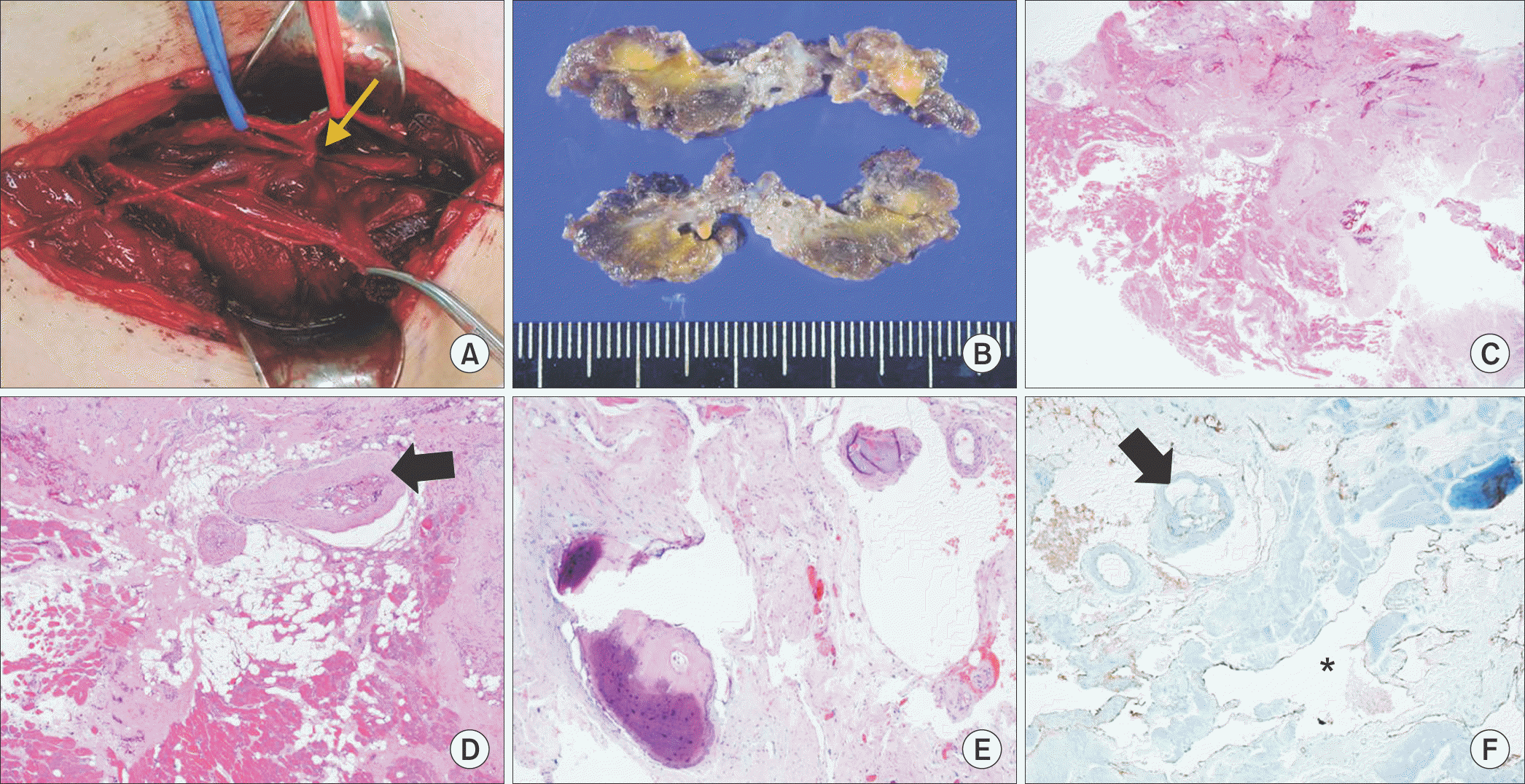Abstract
Arteriovenous malformations (AVMs) are characterized by the presence of abnormal connections between feeding arteries and draining veins. It is generally assumed that symptomatic lesions can preferably be treated. Due to high arterial blood flow, there is a risk of bleeding with surgical excision alone, which can be massive and life threatening during the operation. According to recent advances in interventional technique, a hybrid approach using embolization of the feeding artery with subsequent immediate excision of the AVM for successful management of vascular lesions could be applied to AVMs. Herein, we describe a case of successful excision of AVM in the left soleus muscle using a hybrid approach.
REFERENCES
1.Kim JY., Kim DI., Do YS., Lee BB., Kim YW., Shin SW, et al. Surgical treatment for congenital arteriovenous malformation: 10 years’ experience. Eur J Vasc Endovasc Surg. 2006. 32:101–6.

2.Hristov N., Atanasov Z., Zafirovski G., Mitrev Z. Intramuscular cavernous hemangioma in the left soleus muscle: successful surgical treatment. Interact Cardiovasc Thorac Surg. 2011. 13:521–2.

3.Mendonca DA., McCafferty I., Nishikawa H., Lester R. Venous malformations of the limbs: the Birmingham experience, comparisons and classification in children. J Plast Reconstr Aesthet Surg. 2010. 63:383–9.

4.Nazzi V., Messina G., Dones I., Ferroli P., Broggi G. Surgical removal of intramuscular arteriovenous hemangioma of the upper left forearm compressing radial nerve branches. J Neurosurg. 2008. 108:808–11.

5.Kim DH., Hwang M., Kang YK., Kim IJ., Park YK. Intramuscular hemangioma mimicking myofascial pain syndrome: a case re-port. J Korean Med Sci. 2007. 22:580–2.

6.Belov S. Anatomopathological classification of congenital vascular defects. Semin Vasc Surg. 1993. 6:219–24.
7.Lee BB. Critical issues in management of congenital vascular malformation. Ann Vasc Surg. 2004. 18:380–92.

8.Choke E., McCarthy M. Hybrid procedures in vascular surgery: converging technique to improve results. J Cardiovasc Surg (To-rino). 2010. 51:857–9.
Figure 1.
Radiologic findings of arteriovenous malformation in the soleus muscle. (A, B) Axial and coronal T1-weighted magnetic resonance (MR) image shows iso-intense lesion in medial aspect of soleus muscle in left lower extremity. (C, D) T2-weighted MR image shows bright, highly intense, and round shaped lesion with dimentions of 1.6×1.6×2.7 cm. (E) Angiogram of left lower extremity arteries; digital subtraction angiography shows about 4 cm sized vascular malformation feed from left posterior tibial artery. (F) Post-embolization arteriogram; feeding artery was successfully embolized with gelfoam and microcoil.

Figure 2.
Macro- and microscopic findings of arteriovenous malformation in the soleus muscle. (A) Arrow indicates embolized feeding artery which is arized from posterior tibial artery. (B) The cut section of resected specimen reveals mixed fibrofatty tissue and muscle containing several medium-sized blood vessels. (C) At the low power view, a mixture of varying sized vessels, fatty tissue, and muscular tissue is noted (H&E stain, ×12.5). (D) A thick walled vessel with embolization material is noted on the upper portion (arrow), and area of mixed fatty and muscular tissue is seen on the center (H&E stain, ×40). (E) Some vessel has fibrously thickend wall with osseous metaplasia (H&E stain, ×100). (F) Artery (arrow) and dilated vascular channel (asterisk) are connected within the muscle bundles. Factor-VIII highlights endothelial cells in both artery and vascular channel (Factor-VIII stain, ×100)





 PDF
PDF ePub
ePub Citation
Citation Print
Print


 XML Download
XML Download